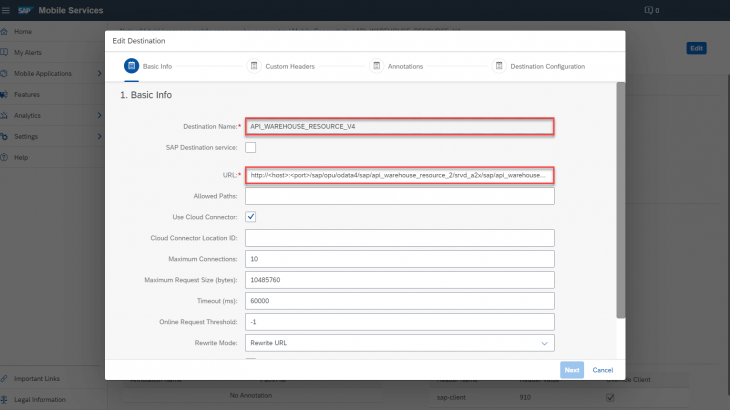Introduction
SAP Warehouse Operator, the newly released native app for SAP Enterprise Warehouse Management (SAP EWM), is now available for Apple iPhones. You can learn more on how to get started with SAP Warehouse Operator in this blog post.
To use SAP Warehouse Operator, there are few pre-requisites:
- You need SAP S/4HANA OP
- You need SAP Business Technology Platform with SAP Mobile Services
- You need SAP Cloud Connector
- You need to use Apple iPhone 11 or higher with Apple iOS 14 or above
The SAP Warehouse Operator app can be downloaded for free from Apple App Store here or using the QR code below.

With this blog post, I will give you a picture of three scenarios on how to get started with SAP Warehouse Operator. You may apply one of these scenarios to your situation.
- You wish to find out the features provided by the app in a demo mode.
- You already are using SAP Business Technology Platform (SAP BTP) and would like to start using SAP Warehouse Operator.
- You wish guidance on how to setup the needed components to experience the SAP Warehouse Operator.
Scenario 1: Explore app features in the demo mode
You have downloaded the app from the Apple App Store. Provided with the app, you can access the demo mode and immediately experience the features of the app. Simply choose the option “Try the Demo” when opening SAP Warehouse Operator on your device.
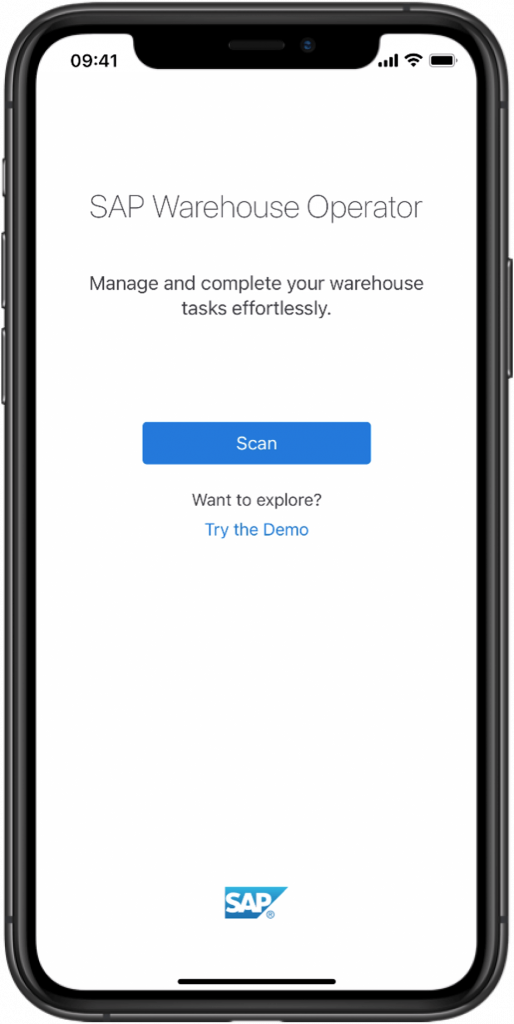
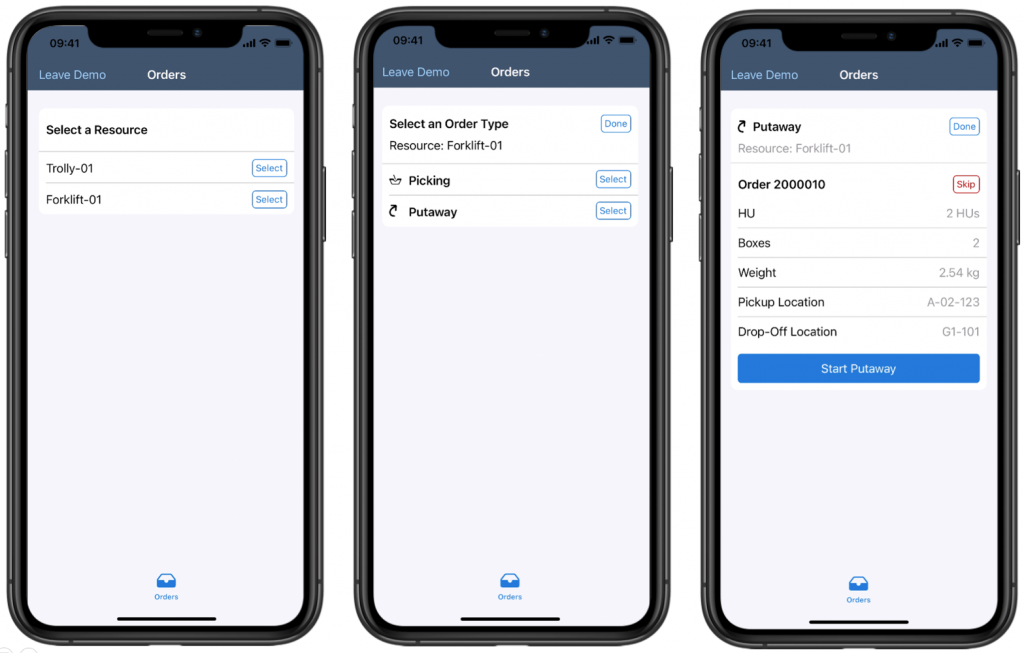
Scenario 2: You already have SAP S/4HANA 2021, are using SAP Business Technology Platform with SAP Mobile Services and would like to start using SAP Warehouse Operator
If you already are running SAP EWM on SAP S/4HANA OP 2021 with SAP Cloud Connector in your system environment and are using SAP Business Technology Platform with SAP Mobile Services, most of these building blocks are in place and ready to accommodate SAP Warehouse Operator.
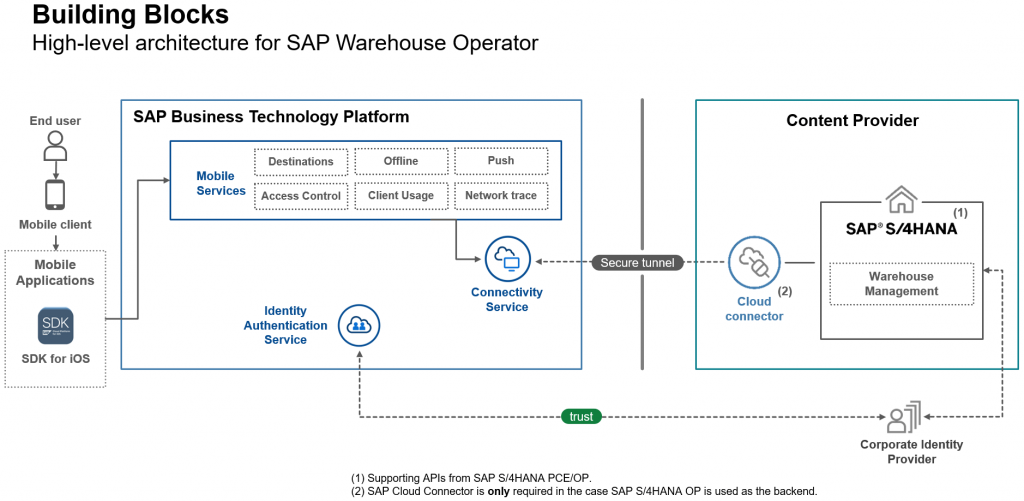
As the content provider for SAP Warehouse Operator, SAP S/4HANA 2021 comes with external APIs, which are used by the SAP Warehouse Operator app. These APIs need to be enabled in your SAP EWM embedded in SAP S/4HANA system or decentralized SAP EWM based on SAP S/4HANA.
Publishing Service Groups
As follows, the current version of SAP Warehouse Operator utilizes following ODATA V4 APIs for which the corresponding service groups need to be published in your SAP S/4HANA backend system.
- API_WAREHOUSE_RESOURCE_2
- API_WAREHOUSE_2
- API_WAREHOUSE_ORDER_TASK_2
To publish above APIs logon to your SAP S/4HANA OP 2021 backend system and start transaction /IWFND/V4_ADMIN as shown below.

Open the ‘Service Groups’ folder on the left panel by clicking on the arrow left to the folder ‘Service Groups’ to access the list of available service groups, like Service Group API_WAREHOUSE_2, API_WAREHOUSE_ORDER_TASK_2 and API_WAREHOUSE_RESOURCE_2.

Note: If you do not see these service groups here, you have to use the Publish Service Groups button.

Click on the button ‘Publish Service Groups’, which will open following screen. From here you can trigger the ‘Get Service Group’ function. You will be presented with a list of entries from where you can then select the needed 3 service groups API_WAREHOUSE_2, API_WAREHOUSE_ORDER_TASK_2 and API_WAREHOUSE_RESOURCE_2 from the populated ‘Not Published Service Groups’ list


Once the needed service groups are listed like shown below, select a service group (e.g. API_WAREHOUSE_RESOURCE_2) and publish this by hitting the button ‘Publish Service Group’. Repeat these steps for all remaining service groups mentioned above.

If you have followed these steps to publish missing service groups, you should now be able to access these in the folder ‘Service Groups’ of the transaction /IWFND/V4_ADMIN.

To run a check, if a service group returns and can provide possible data to the SAP Warehouse Operator app, you should execute a service test. As an example, we will select the service group API_WAREHOUSE_RESOURCE_2 and perform this test by clicking the ‘Service Test’ button.

Once you have clicked on ‘Service Test’, you should be presented with the following screen, where you first click on the button ‘Entity Set’, then select ‘WarehouseResource’ from the popup and finally execute the test using the ‘Execute’ button.

If all goes well, you should receive a HTTP Response with status code 200 and some results of your SAP EWM resources maintained in your SAP S/4HANA OP system.
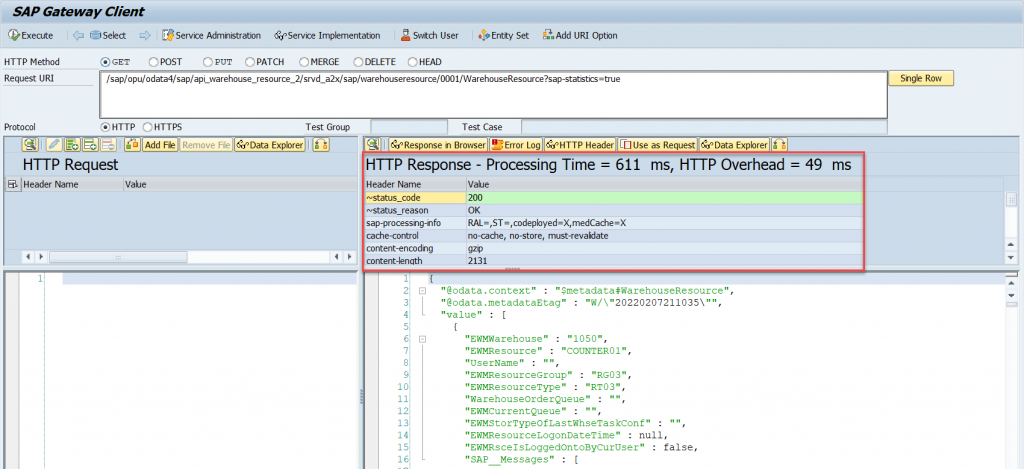
This concludes the publishing and initial testing of Service Groups used for SAP Warehouse Operator.
With the steps noted above, you can now configure mobile destination on SAP Mobile Services, assuming you are already running SAP Business Technology Platform with connectivity setup via SAP Cloud Connector to your SAP S/4HANA OP 2021 system.
Creating Mobile Destinations
In above section you have seen that the SAP Warehouse Operator app connects to API endpoint on your SAP S/4HANA OP 2021 system. These need to be configured in SAP Mobile Services as part of SAP Business Technology Platform.
In this section you’ll learn how to configure the mobile destination on SAP Mobile Service for the SAP Warehouse Operator app.
With your SAP Mobile Services up and running logon to your SAP Mobile Services cockpit.
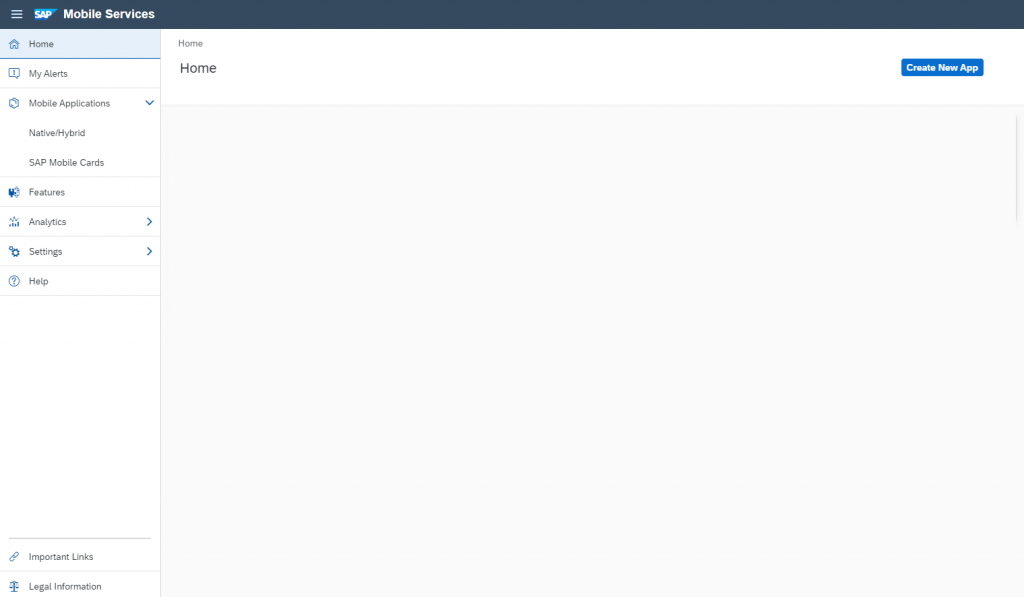
Next, select ‘Native/Hybrid’ from the left panel of the cockpit and create a new entry using the ‘New’ button as shown below.
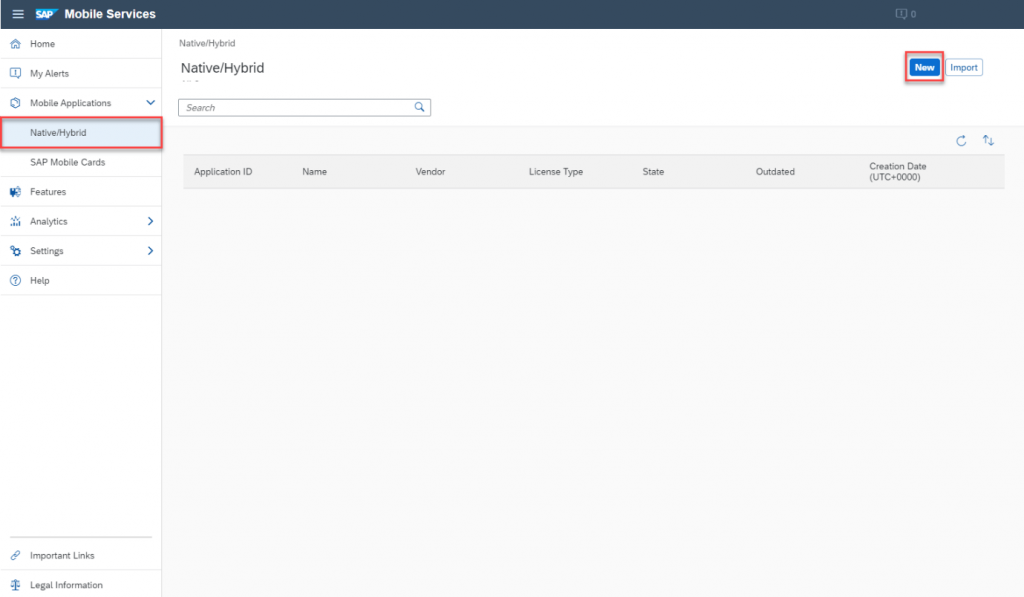
As follows, you will need to maintain both mandatory fields ‘ID’ and ‘Name’ for basic information.
- ID: sap.mobile.apps.warehouseoperator
- Name: SAP Warehouse Operator
Enter for both fields the entries as displayed below. Click ‘Next’.
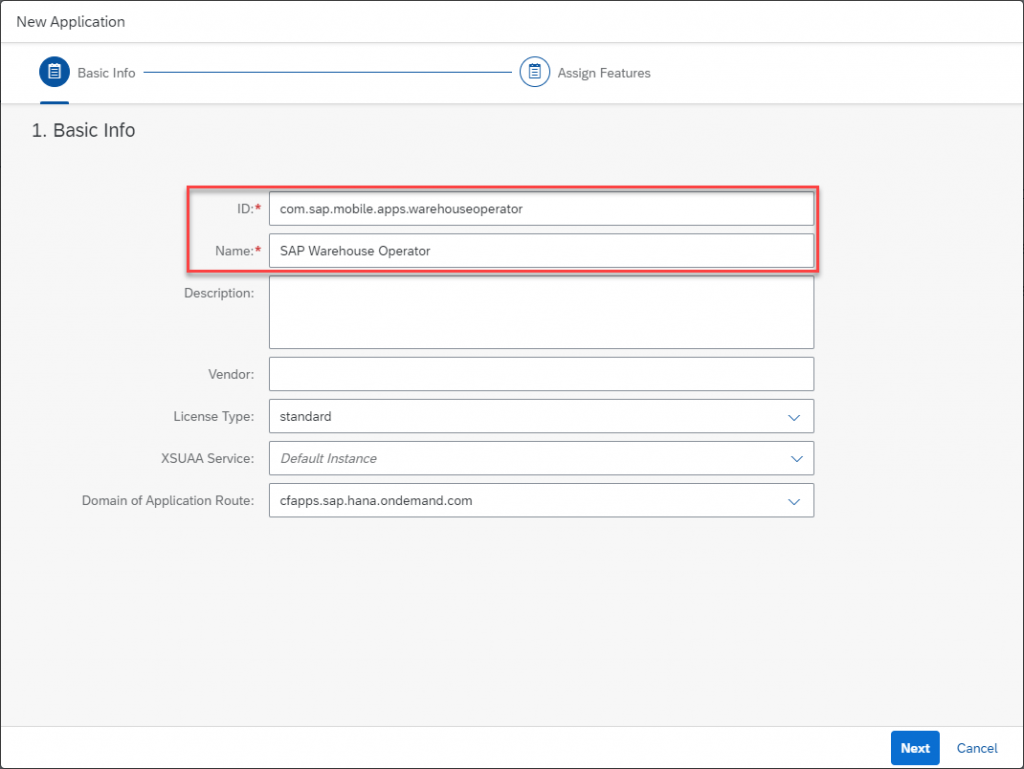
In a second and final step, you assign features for the native application. Default assigned features like ‘Mobile Offline Access’ or ‘Mobile Augmented Reality’ not needed for the SAP Warehouse Operator app, have been de-selected by un-checking the appropriate check-boxes. Select ‘Mobile Connectivity’ from the list, if not yet already marked as checked and click ‘Finish’.
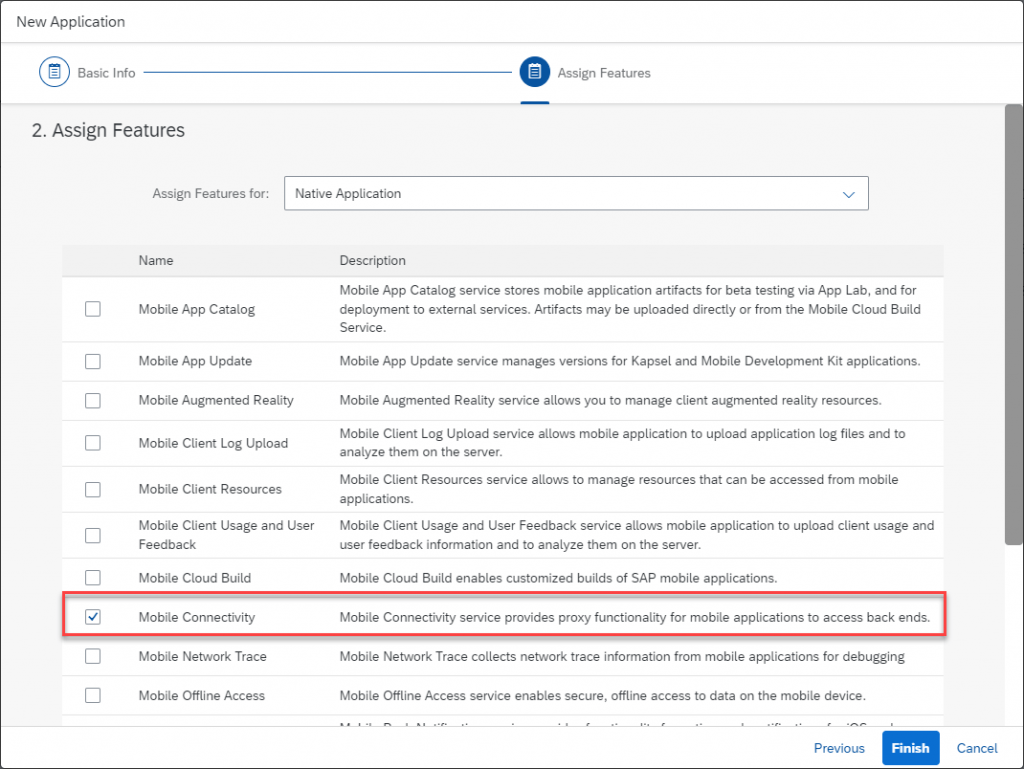
Once the application ‘SAP Warehouse Operator’ has been created, you can create mobile destinations by clicking on ‘Mobile Connectivity’ from the assigned features list on the left hand side of the screen as shown below.
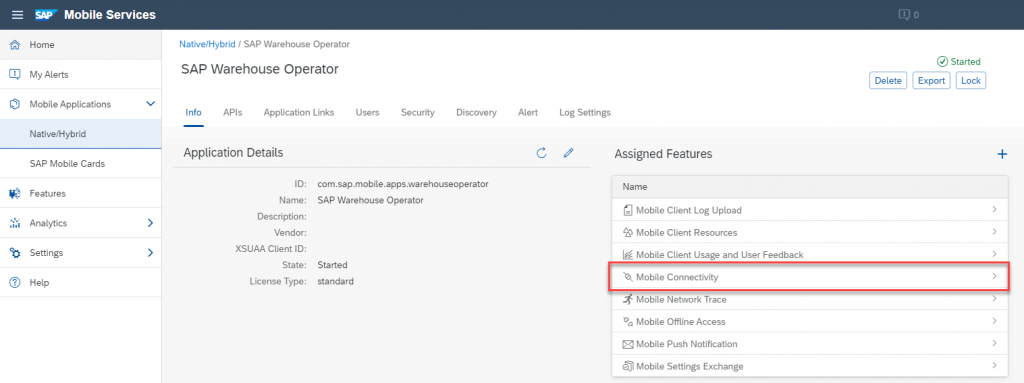
Clicking on ‘Mobile Connectivity, will result in a screen ‘Mobile Connectivity’ with no entries for ‘Mobile Destinations’. In the presented screen, select the ‘Create’ button on the right hand side of the screen has highlighted below.

A guided step-by-step procedure will help you to create the mobile destinations, which point to the mentioned external APIs provided by your SAP S/4HANA OP 2021 system. As an example, we will create a new mobile destination for the SAP S/4HANA OP 2021 service group API_WAREHOUSE_RESOURCE_2.
Providing basic information
- Enter API_WAREHOUSE_RESOURCE_V4 into the field ‘Destination Name’.
- Enter the URL http://<host>:<port>/sap/opu/odata4/sap/api_warehouse_resource_2/srvd_a2x/sap/api_warehouse_resource_2/0001/ which should point to the virtual host of your SAP Cloud Connector. Replace <host> and <port> with your respective host and port name of your SAP Cloud Connector.
- Check the usage of Cloud Connector
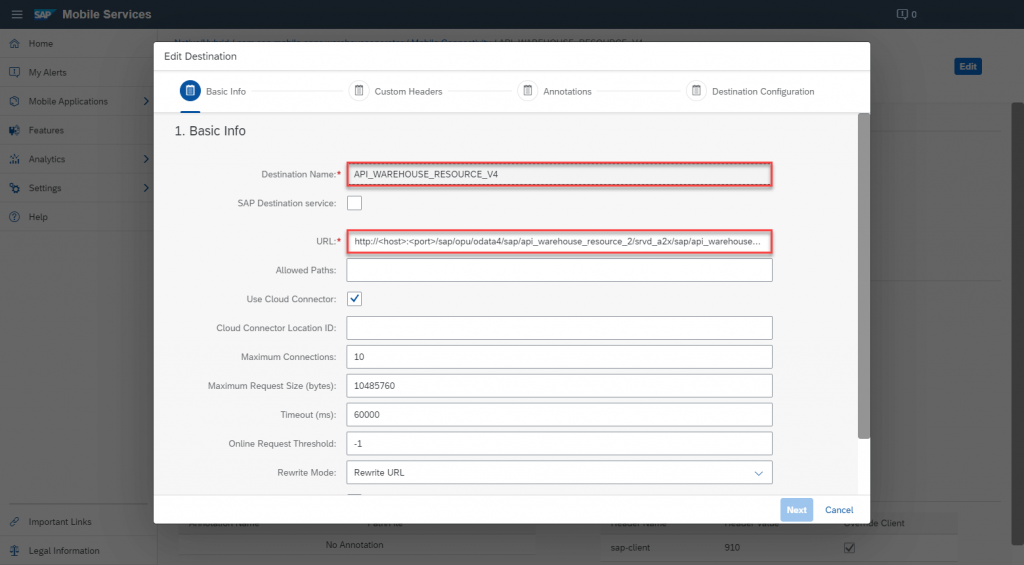
Note: For information on parameter values for fields like ‘Maximum Connections’ or ‘Timeout (ms)’ please refer to the official help documentation for SAP Mobile Services at this link.
- Maintain custom Headers (optional)
- If you wish to configure the destination to connect to a specific SAP S/4HANA client, you can create the ‘Header Name’ sap-client and provide a value for the sap-client parameter – the key/value pair(s) will be sent to the backend with each request.
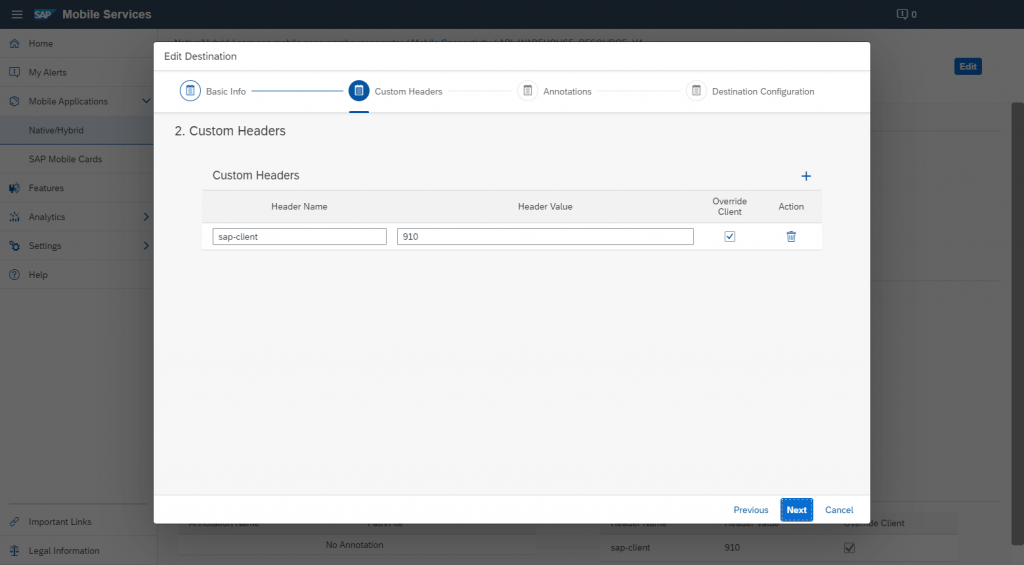
- Configure annotations (not needed).
- Configure Destination
- In this final step you general configure which SSO Mechanism is to be used for the mobile destination. Here you select a single-sign-on option from a list of available options. If for example you which to enable principal propagation through SAP Cloud Connector, then choose Cloud Connector SSO from the available options.
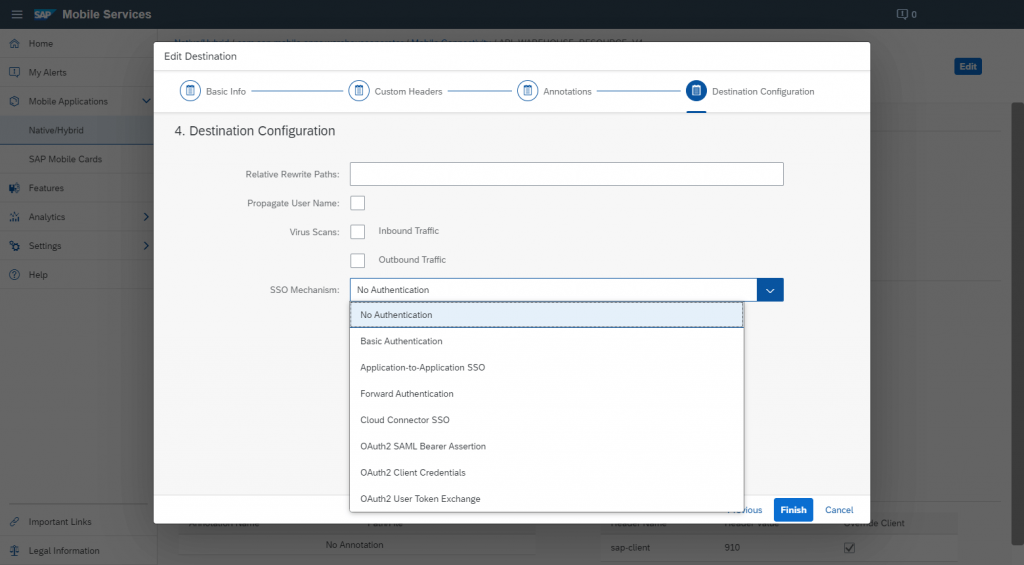
To finish the last step, click on ‘Finish’ to finalize the configuration this mobile destinations on SAP Mobile Services. For the configuration of the remaining mobile destinations API_WAREHOUSE_V4, API_WAREHOUSE_ORDER_TASK_V4 and com.sap.mobile.apps.warehouseoperator please refer to the official help documentation for SAP Warehouse Operator – section Configure Mobile Services -> Create Destinations.
Where to find the QR code for app onboarding
Once you have performed all necessary configuration steps for the SAP Warehouse Operator app and need to scan the QR code during the app onboarding step, here is how to find the QR code.
From the cockpit of your SAP Mobile Services click on Mobile Applications -> Native/Hybrid and select SAP Warehouse Operator from the list. The onboarding QR code can be found by clicking on the API tab, as shown below.
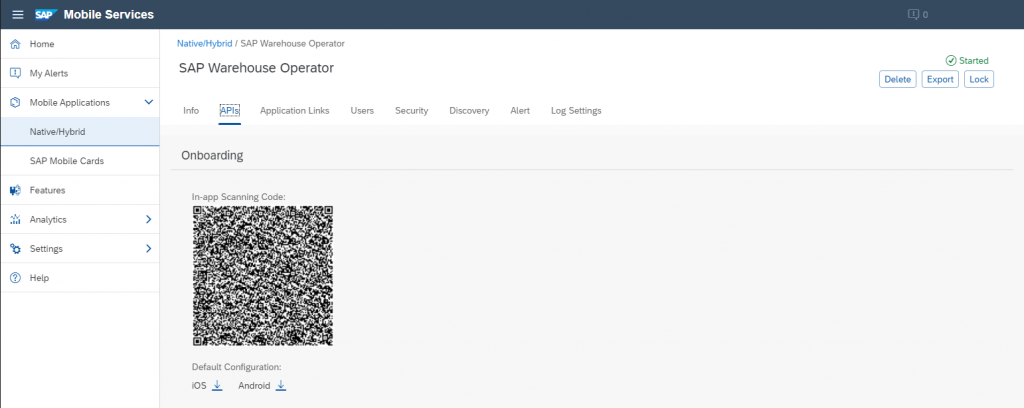
Scenario 3: You wish guidance on how to setup the needed components to experience the SAP Warehouse Operator
An overview of the building blocks to operate the SAP Warehouse Operator app with the general system prerequisites, overall configuration steps and security topics is provided to you under the SAP Help Portal.
